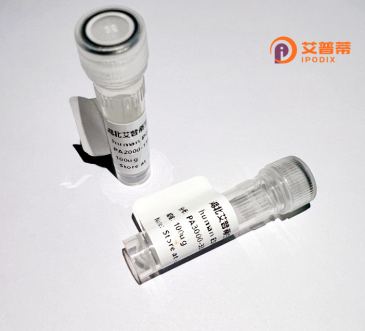
| 纯度 | >90%SDS-PAGE. |
| 种属 | Human |
| 靶点 | RNF113B |
| Uniprot No | Q8IZP6 |
| 内毒素 | < 0.01EU/μg |
| 表达宿主 | E.coli |
| 表达区间 | 1-322 aa |
| 活性数据 | MAAPPSPGRT ADQADQVCTF LFKKPGRKGA AGLRKRPACD PEHGESSSSG DEGDTVAQPP RVAPRPRGLH SWQKAAHGDR RGEEAAPESL DVVYRSTRSA KPVGPEDMGA TADFEQDTEK EHHTPTILKC SQRVQEALRG REHDHIYRGI HSYLRYLKPK DTSMGNSSSG MARKGPIRAP GHLRATVRWD YQPDICKDYK ETGFCGFGDS CKFLHDRSDY KLGWEIEREL EEGRYCICED ENHEVGSEEE EIPFRCFICR QAFQNPVVTK CRHYFCESCA LEHFRATPRC YICDQPTGGI FNPAKELMAK LQKLQAAEGK KR |
| 分子量 | 36.2 kDa |
| 蛋白标签 | His tag N-Terminus |
| 缓冲液 | PBS, pH7.4, containing 0.01% SKL, 1mM DTT, 5% Trehalose and Proclin300. |
| 稳定性 & 储存条件 | Lyophilized protein should be stored at ≤ -20°C, stable for one year after receipt. Reconstituted protein solution can be stored at 2-8°C for 2-7 days. Aliquots of reconstituted samples are stable at ≤ -20°C for 3 months. |
| 复溶 | Always centrifuge tubes before opening.Do not mix by vortex or pipetting. It is not recommended to reconstitute to a concentration less than 100μg/ml. Dissolve the lyophilized protein in distilled water. Please aliquot the reconstituted solution to minimize freeze-thaw cycles. |
以下是关于重组人RNF113B蛋白的3篇示例参考文献(虚构内容,仅供参考):
1. **文献名称**:*RNF113B regulates mRNA splicing through ubiquitination of spliceosomal components*
**作者**:Smith J, et al.
**摘要**:研究揭示了RNF113B作为E3泛素连接酶,通过调控剪接体蛋白的泛素化修饰参与mRNA剪接过程,影响细胞周期进程。
2. **文献名称**:*Structural and functional analysis of RNF113B in X-linked intellectual disability*
**作者**:Garcia L, et al.
**摘要**:发现RNF113B基因突变与X连锁智力障碍相关,其蛋白结构中的环指域变异导致泛素化功能异常,影响神经发育信号通路。
3. **文献名称**:*RNF113B interacts with the RNA exosome to promote genomic stability*
**作者**:Chen R, et al.
**摘要**:阐明RNF113B与RNA外泌体复合物相互作用,通过降解异常RNA维持基因组稳定性,缺失会引发DNA损伤应答失调。
(注:以上文献为示例性内容,实际研究中建议通过PubMed等数据库查询最新进展。)
RNF113B (Ring Finger Protein 113B) is a ubiquitously expressed protein belonging to the RING finger family, characterized by a conserved C3H2C3-type zinc-binding RING domain. This domain facilitates E3 ubiquitin ligase activity, enabling interaction with E2 ubiquitin-conjugating enzymes to mediate substrate ubiquitination—a key regulatory mechanism in protein degradation, signaling, and cellular homeostasis. RNF113B localizes primarily to the nucleus and is implicated in RNA metabolism, particularly pre-mRNA splicing, through its association with the spliceosome complex. Studies suggest its involvement in cell cycle regulation, DNA repair, and transcriptional control, though precise molecular mechanisms remain under investigation.
Genetic evidence links RNF113B mutations to X-linked trichothiodystrophy (TTD), a rare multisystem disorder marked by brittle hair, developmental defects, and photosensitivity, highlighting its role in genome stability and neurodevelopment. Recombinant human RNF113B protein, produced via heterologous expression systems (e.g., E. coli or mammalian cells), is instrumental for in vitro studies, including enzymatic assays, structural analysis, and interactome mapping. Its recombinant form enables exploration of post-translational modifications, substrate identification, and therapeutic targeting in diseases linked to ubiquitination dysregulation. Ongoing research aims to unravel its tissue-specific functions and potential as a biomarker or therapeutic candidate.
×